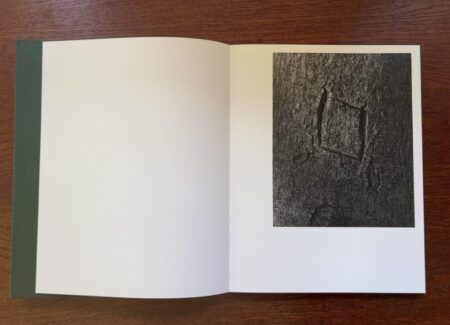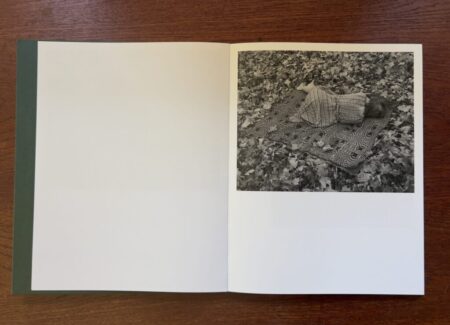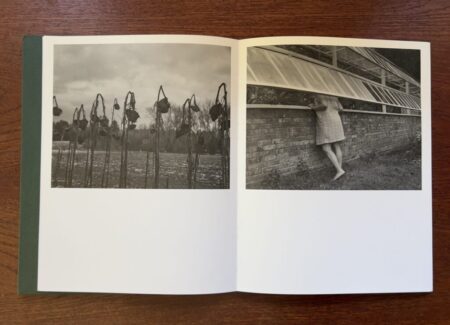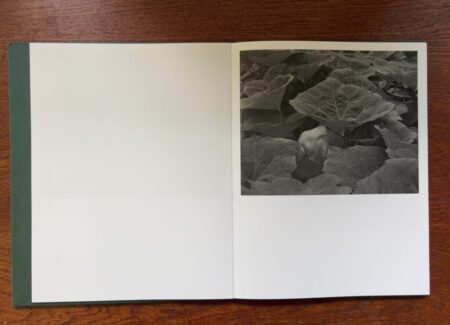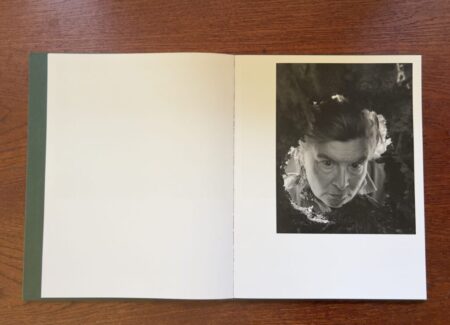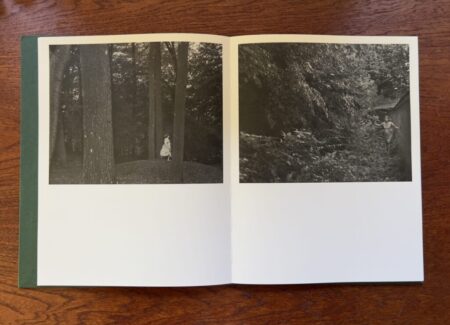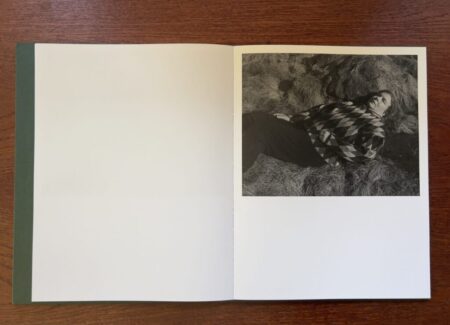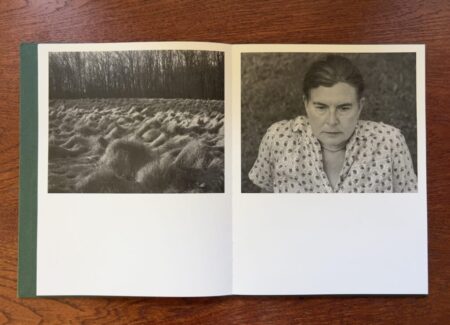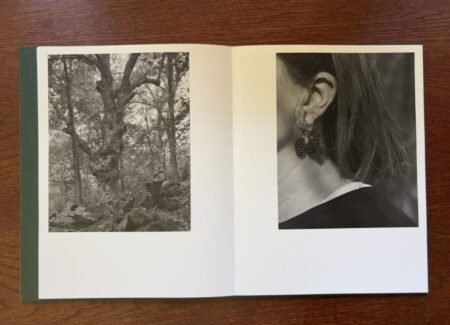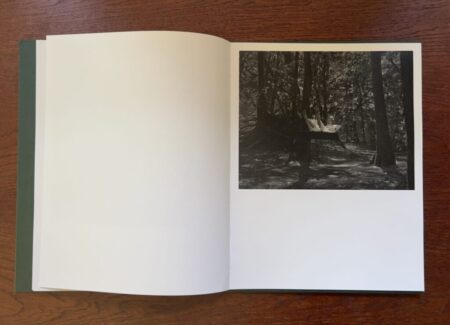JTF (just the facts): Published in 2025 by L’Artiere (here). Hardcover (22.5 x 29 cm), 72 pages, with approximately 67 black-and-white reproductions. Includes a short essay by Laura McPhee. In an edition of 750 copies. Design by Teresa Piardi. (Cover and spread shots below.)
Comments / Context: The American photographer Scott Offen has doggedly pursued the craft of photography over the last decade, earning both a BFA and an MFA in photography from Massachusetts College of Art and Design in Boston within the past five years. His wife, Grace, to whom he has been married for 43 years, is the primary subject of his debut monograph Grace, published earlier this year by L’Artiere Edizione. Using large format view cameras, Offen has spent the last seven years photographing his wife and what appears to be the landscape of the northeastern United States to create an eccentric and deeply psychological depiction of a woman entering her golden years.
The hardcover photobook is meticulously crafted to immediately engage the viewer. Its evergreen cover offers a sense of timelessness and nature’s enduring presence, a feeling enhanced by the clean, white embossed text that clearly states the title, Grace, and the author’s name. The understated elegance of the cover is dramatically interrupted by a precisely executed central die-cut circle. This aperture functions as a peephole, offering a glimpse into the book’s interior. Through this circular frame, the viewer encounters a striking black and white photograph. The image depicts a profusion of lush tree leaves, their forms overlapping and creating a sense of depth and vitality. This imagery intimately surrounds a contrasting subject: a bare, aged human back. The skin appears to sag, bearing the marks of time and gravity, and the subject’s spine is subtly visible beneath the surface. The cover image is the prelude for pairings and sequences that are smartly formal and elegant within the book, where the relationship between the human form and the natural world is a consistent motif.
The photographs in this book evoke a sense of mystery, as if encoded with a secret language. The initial image, a close-up of a rectangular tree engraving of indeterminate origin, immediately poses questions: where is this, and who is Grace? Though maple and oak leaves offer a familiar detail, the book’s deliberate sequencing and pacing encourage a personal journey of discovery. The subject, a single figure revealed through careful observation of her form, remains faceless for many pages. We see her lying on autumn leaves, embracing a distant boulder, and sitting barefoot atop another, showing only her ankles, hands, and feet. Photographs of nature alternate with photographs of the woman’s form. Her face is not shown until about one-third of the way through the book.
Grace’s visage is finally revealed after the cover image appears in the elegance of its full frame view. Her face is shown closeup, surrounded by darkness while her face is illuminated. She appears as if she is looking into a peephole herself, looking back into the darkness, toward the viewer but not at us, with an unsettling gaze, seemingly searching. Throughout the subsequent images, Grace is consistently photographed outdoors in nature. If she is not in nature and instead in a domestic space, her facial expression appears incredibly distraught, more so than when she is outside running between trees or swinging between them. She never directly meets the viewer’s gaze, instead always looking elsewhere, absorbed in her own private and unknowable world.
My favorite spread in the book is just beyond the halfway point. On the left facing page we’re shown a dying tree in the forest, and across the book’s gutter on the right side appears a close up of Grace’s ear with a makeshift earring of three miniature pine cones, seen with the incredible clarity of the view camera, scotch-taped to her lobe. The playfulness of the act of adhering jewelry to one’s body in this way allows me to look more playfully at the trunk of the dying tree that precedes it to allow myself to see forms within it, much like one might allow their imagination to wander when looking at a cloud.
Offen’s photographs of Grace evoke shades of Eleanor Callahan as photographed by her husband, Harry Callahan, throughout their 50-year photographic partnership, a significant portion of their 63 years together. The representation of Eleanor as seen by Harry is legendary; their connection immortalized by the images made together. Two of Offen’s images particularly recall the echo of Callahan: the book cover photograph juxtaposing the human figure with spring foliage, and a distant shot of Grace in a sundress and glasses, arms outstretched with one hand on a house and the other holding a fistful of soil while reaching towards trees. While Offen’s credentials suggest that he is fairly new to the medium, this is likely a misnomer. Beyond the obvious link to Callahan, Offen’s work shows formal and thematic reference to the work of Emmet Gowin, Nicholas Nixon, and Lee Friedlander, other modernists who made their mark by working with their wives as their muses over the course of the 20th century.
After the photobook’s colophon page is a three paragraph text by photographer Laura McPhee titled “Wood River, Valley, Idaho” written in January of 2025. McPhee herein delves into explanation of the particulars that make the photographs of the book a true collaboration, one “that transcend[s] the tradition of active man with a camera and passive wife as sitter” rather than a project of the male gaze. From her pithy text it is evident that McPhee knows the Offens and their working process very well. After flipping through the book once and reading McPhee’s contribution at the conclusion, the viewer is invited to re-read and reconsider the role of muse versus collaborator, the dynamic between photographer and subject, and the potential for shared spontaneous activity in this work with new insight.
L’Artiere continues to impress with Grace, delivering another thoughtfully crafted and exquisitely printed photobook. Its sleek and classic design compliments the evocative imagery within the book’s pages, probing questions about the intimacy of a married couple and their joint photographic authorship as collaborators, despite who masterfully composes the unruly view camera and who sits in front of its lens.
Collector’s POV: Scott Offen does not appear to have consistent gallery representation at this time. Collectors interested in following up should likely connect directly with the artist via his website (linked in the sidebar).

